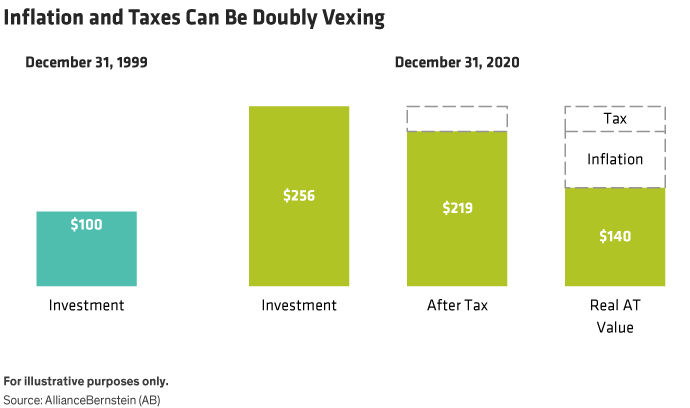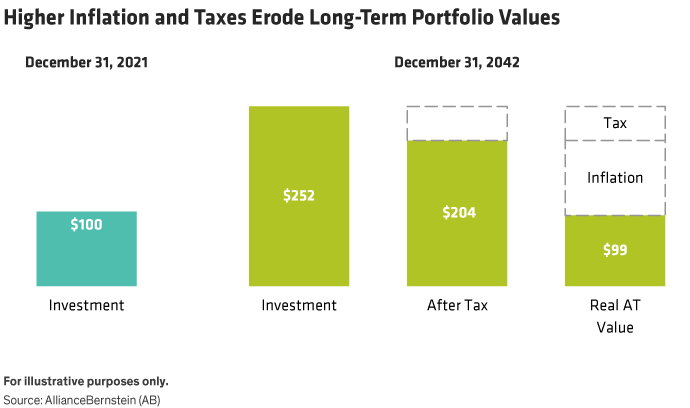Investing is all about growing your spending power over time. That’s why most taxable investors realize that pretax profits must be adjusted downwards to account for taxes. And that’s not the only hit. To gauge the true strength of your purchasing power, “nominal” returns must be further reduced by the rate of inflation. Think of it as a double whammy.
Imagine, for example, that you had put $100 into the S&P 500 Index at the end of 1999 and spent the dividends each year but otherwise let the investment compound until the end of 2020. Over that 21-year period, your investment would have grown to approximately $256. When you cash in, you pay taxes on the gain, and end up with about $219 (assuming a capital gains rate of 23.8%).
But during this period, your investments weren’t the only thing taking off. The cost of goods and services rose, too. In fact, you now need $155 to buy the same basket of goods and services you could have bought for $100 at the end of 1999. As a result, your portfolio's value in 1999-dollar terms (despite 21 years of growth) is only about $141. That is a real after-tax return of just 1.6% per year—over two whole decades (Display).[1]

The problem (for taxable investors) is that capital gains taxes are levied on your nominal return, not on your real return. This means that the effective capital gains tax rate on your real return is much higher than it seems at first glance. In fact, during inflationary episodes, it can exceed 100%!
Rising Inflation and Taxes
Instead of looking back, what about the future? Let’s assume that inflation averages 3.5% over the next 21 years (rather than the 2.1% it averaged since 1999)—a scenario with a 40% chance of unfolding, according to our analysis. What’s more, let’s assume that the price of the S&P 500 compounds at only 4.5% (in line with the average over the past 21 years), and that the capital gains tax rate increases so that an investor now pays an all-in rate of 31.8%.[2]
With these changes, we’d expect $100 to grow to $252 in nominal dollars by 2042. But after taxes and inflation, this figure drops to only $99 in real (2021) dollars. Even though stocks have delivered 4.5% per year for two decades, the spending power of your principal has declined after taxes and inflation (Display).[3]

How to Handle Headwinds
So, how should taxable investors prepare for the prospect of both inflation and capital gains tax rates increases today? Essentially, there are two paths. First, if you’re sensitive to inflation, consider protecting your portfolio with an inflation hedge. Second, invest more tax efficiently by deferring the tax hit for as long as possible.
Tax deferral improves after-tax returns by limiting the steady erosion of your portfolio’s value. In other words, it keeps more money at work earning a return. There are many ways to accomplish this. For instance, real estate investors have long taken advantage of section 1031 exchanges to delay capital gains taxes by rolling over sales’ proceeds into a new property. Investors in public securities can avail themselves of tax efficient vehicles like index ETFs, or by combining direct index tax loss harvesting strategies with active equity solutions. Other options include vehicles like retirement plans or life insurance.
Put Time on Your Side
To demonstrate the power of tax deferral, let’s revisit the investor in our last example. After letting his investment ride and deferring the taxes for 21 years, he could count on a compound annual real after-tax return of -0.05% (factoring in inflation). In other words, he’s essentially running in place, keeping up with inflation after taxes.
But he’s still ahead of our second, less savvy investor who fails to defer taxes. She also sees 4.5% in price appreciation, pays tax on it at 31.8%—losing 1.4%—then watches her purchasing power fall by another 3.5%. That boils down to an annual real after-tax return of −0.43%. Put another way, by allowing her profit to be taxed year in and year out, she ends up taking a step backward.
Clearly, tax deferral improves outcomes. Not surprisingly, the benefit increases when the nominal returns are larger, while dwindling when they’re smaller. What’s more, the benefit persists regardless of inflation’s path. In other words, whether inflation spikes or not, deferral will still help you.
The Best of Both Worlds
The twin perils of taxes and inflation both tend to chip away at taxable investors’ portfolios. To create a buffer, find the optimal mix of real assets that strikes the best balance between inflation sensitivity, reliability, and cost—then defer taxation on the returns of those investments for the longest period possible.
[1] CPI rose by 55.03% over this period.
[2] Including the new 25% rate, the new 3% surcharge, and the current 3.8% surtax on net investment income, the highest marginal long-term capital gain tax rate would rise to 31.8% under the House Ways & Means most recent proposal.
[3] Now, $100 will grow to $252.02. After taxes, that becomes $203.68. But the basket of goods and services you could have bought at the end of 2020 for $100 now costs $205.94. This means that your portfolio's value in 2021 dollars (again, after 21 years of growth) is only $98.90.
- Paul Roberston
- Senior National Director, Tax & Transition Strategies—Investment Strategies Group

